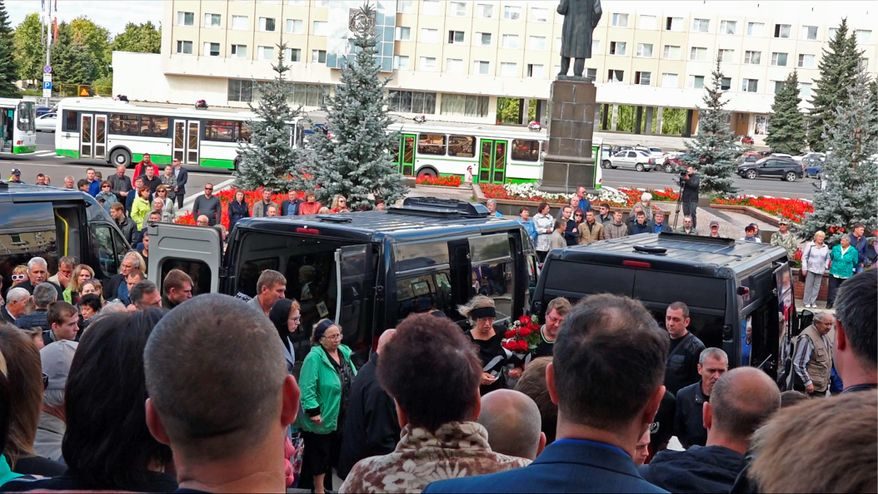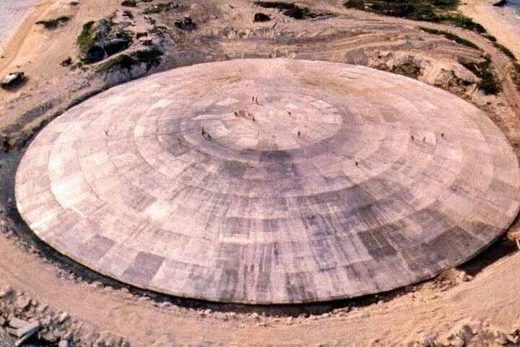Comment: File this one under "No sh*t, Sherlock..."

The reactor exploded Aug. 8 off the coast of the northern Russian town of Nenoska, killing seven Russians on a barge in the White Sea as they were overseeing the recovery of a sunken Skyfall. The missile had been sitting on the seafloor for about year after a failed flight test, said State Department official Thomas G. DiNanno.
"The explosion was caused by the Skyfall experiencing a criticality accident, an uncontrolled nuclear reaction that released a burst of radiation while Russian personnel retrieved it from the seafloor," Mr. DiNanno said in an interview with The Washington Times.
The reactor exploded in the Arkhangelsk region in Russia's far north near populated areas and triggered concerns about fallout spreading to the Baltic states of Latvia, Estonia and Lithuania, as well as Sweden, Denmark and Finland, he said.
"The missile sat on the seabed since its failed test early last year in close proximity to a major population center," Mr. DiNanno said.
"What really concerns us, No. 1, is the disinformation; No. 2, that it sat at the bottom of the ocean for a year; and No. 3, their first reaction was to cover it up," he added.
Comment: "What really concerns" the US State Department is gloating over this successful sabotage mission.
Mr. DiNanno is deputy assistant secretary of state and a senior official in the Bureau of Arms Control, Verification and Compliance. He first disclosed the Skyfall incident Oct. 10 in a speech to the United Nations General Assembly First Committee.
In the interview, Mr. DiNanno revealed further details about the incident. As part of the cover-up, he said, Moscow cut off the data gathered by a Russian nuclear monitoring station near the blast. That information is supposed to go to the International Monitoring System, a technical group based in Vienna that operates as a unit of the Comprehensive Test-Ban-Treaty Organization.
The blast was set off after the fuel in the missile reactor was no longer cooled by seawater.
Skyfall, which when deployed will be armed with either nuclear or conventional warheads, could strike at a nearly limitless range. It is one of five strategic nuclear weapons that Mr. Putin announced in March 2018 "very bombastically," Mr. DiNanno said.
Comment: DiNanno is jealous the US is trying but failing miserably at producing such hi-tech weaponry: Putin details why Russia's military tech changes balance of power
Another superweapon under development is the Poseidon drone torpedo, also nuclear powered, which will carry a warhead up to 450 kilotons and which the State Department arms official described as a "doomsday weapon."
The other three weapons are the Sarmat multiwarhead intercontinental ballistic missile, the Avangard hypersonic missile and the Kinzhal air-launched ballistic missile.
"These are extremely destabilizing systems. A nuclear powered cruise missile could stay seemingly aloft for a long time," Mr. DiNanno said.
U.S. monitoring agencies estimated that the environmental impact of the reactor blast was confined locally.
"From what I understand, the actual radiation cloud was not dangerous per se," Mr. DiNanno said. "But our issue is with the lack of transparency and the cover-up and the misinformation."
The blast was measured to be 2.4 magnitude on the seismic scale, he said.
"A relatively small explosion but dangerous enough when a nuclear reactor explodes," Mr. DiNanno said. "The point here is why was this system flying around in the first place, why after the crash it sat there for a year, and why it took a recovery operation to sort of expose the original accident."
In the immediate aftermath of the blast, Russia's state-controlled media gave varying explanations for closures of areas on land and at sea without saying they were the result of a missile.
The misinformation included statements that the mishap involved a military exercise, a malfunction in a storm-warning system, and a toxic chemical spill at sea. State-controlled outlets also provided false reports that radiation levels were not elevated.
The disinformation surrounding the Skyfall incident is eerily similar to Moscow's cover-up of the deadly 1986 Chernobyl nuclear power plant explosion in what is now Ukraine.
Comment: Oh go suck a tail-pipe. They're not even close! The first was a tragic accident (albeit with 'help from beyond the veil'); the recent incident was almost certainly out-and-out deep state sabotage. From their POV, Russia's weapons program MUST be stopped, or it's curtains for their 450-year-long reign.
The only reason the Russians kept quiet about it was they don't go publicly whinging and risk exposing details about their new missile tech they never wanted exposed...
The first acknowledgment of the Skyfall accident was the state nuclear agency Rosatom's announcement two days later about the deaths of five scientists.
Mr. DiNanno said Skyfall and other superweapons are destabilizing because they are not covered by any arms treaty. The Trump administration is seeking to include them in any extended New START accord or a new arms treaty with Russia and China, he said.
"Technology has rapidly changed, and it's important that we point out not what New START does, but what it doesn't do in the 2020 deteriorating security environment. It doesn't cover these systems," he said.
Another major worry is the large number of non-strategic nuclear weapons held by Russia and China. Any new arms accord should address those weapons, he added.
Asked why the State Department decided to disclose the latest information, Mr. DiNanno said, "We felt it was important we tell the truth, share what we understood had happened in Nenoska."
Comment: Really. Since when has the US State Department been interested in telling the truth? Sounds like just another attempt at Russia bashing.
The department worked with other government agencies to sift through classified data and imagery and then downgraded its classification so it could be shared with allies and partners, and ultimately the public, he said.
The information about the missile has been known for some time, but the government wanted to make sure it was confident about the accuracy before announcing it to the world.
"We'd like to see that get a little faster, but getting it right is more important," Mr. DiNanno said.
Mr. DiNanno said the goal of announcing the Skyfall incident at the United Nations was to put the Russians and the Chinese on notice that "we're serious about expanding and modernizing the arms control architecture."
Comment: Utter horsesh*t: the US has been proactively dismantling the arms control architecture since 2000.
Mark Schneider, a former Pentagon nuclear policy official who is now a senior analyst with the National Institute for Public Policy, called the nuclear-powered missile "a monument to Putin's irresponsibility" and something that "should never have been created."
"The concept of this weapon is foolish. Russia does not need its unlimited range potential to penetrate the virtually non-existent U.S. strategic air defenses. The probability of successful development was always low, and radiation release was inevitable," he said.
Russia has been questioned about the superweapons, and China so far has rebuffed Trump administration appeals to enter into strategic arms negotiations.
One clue investigators discovered about the reactor blast was local detection of cesium-137, a byproduct of nuclear fission, a State Department official said.
That radioactive material is related to a nuclear reactor. Reports from Russia suggested that the radiation near Nenoska may have been the result of plutonium-fueled batteries. The official said that was incorrect.
Another official described Skyfall as a "flying Superfund site" — a reference to places the Environmental Protection Agency designates as hazardous waste sites that pose a risk to human life.
The Russian Embassy did not return an email request for comment.






Seems like we would have heard about that finding. Maybe, however, the US waited to gripe about Russia until we 'found' and removed the GIANT Nuke that's sat off savanna over 60 years.
That's the only link I've seen to that story, but the timing of our finding seems a little too damn convenient.
R.C.